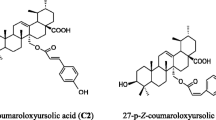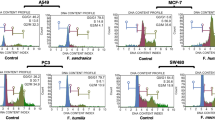Abstract
Although several studies covered anti-proliferative and cytotoxic effects of the rhizome extracts of Kaempferia parviflora Wall. Ex. Baker towards cancer cells, cytotoxicity of its pure methoxyflavone components remains undetermined. The present study was aimed to evaluate the cytotoxicity of 3,5,7,4′-tetramethoxyflavone (TeMF), 5,7,4′-trimethoxyflavone (TMF), and 5-hydroxy-3,7,3′,4′-tetramethoxyflavone (5-H-TeMF) purified from its rhizome extracts on human colorectal carcinoma (HCT-15) cells. All three compounds showed a dose-dependent inhibitory effect on HCT-15 cells. Significant numbers of apoptotic nuclei and condensed chromatin were also observed. TMF produced a higher level of fragmented DNA compared to TeMF and 5-H-TeMF. In addition TMF-treated cells showed the highest levels of caspase-3 activity than those treated with the other two compounds. Caspase-3 activity was reduced when Z-VAD-FMK, a caspase inhibitor, was administered along with each compound. Furthermore, caspase-3 activity was increased by the four concentrations of TMF in a dose-dependent manner. These results strongly suggest that TeMF, TMF, and 5-H-TeMF caused cell death via an apoptotic pathway. Therefore all these compounds have the potentiality to be the novel anti-cancer drugs.
Similar content being viewed by others

References
Alnemri E, Livingston D, Salvesen G, Thormberry N, Wong W, and Yuan J (1996) Human ICE/CED-3 protease nomenclature. Cell 87, 437–442.
Banjerdpongchai R, Suwannachot K, Rattanapanone V, and Sripanidkulchai (2008) Ethanolic rhizome extract from Kaempferia parviflora Wall. Ex. Baker induces apoptosis in HL-60 Cells. Asian Pacific J Cancer Prev 9, 595–600.
Bossy-Wetzel E, Newmeyer DD, and Green DR (1998) Mitochondrial cytochrome C release in apoptosis occurs upstream of DEVD-specic caspase activation and independently of mitochondrial transmembrane depolarization. EMBO J 17, 37–49.
Chomchalow N, Bansiddh IJ, and MacBaine C (2003) Amazing Thai medicinal plants, horticultural research institute (HRI), Department of Agriculture and Horticultural Science Society of Thailand (HSST), Thailand.
Chou CC, Pan SL, Teng CM, and Guh JH (2003) Pharmacological evaluation of several major ingredients of Chinese herbal medicines in human hepatoma Hep3B cells. Eur J Pharm Sci 19, 403–412.
Cornwell T, Cohick W, and Raskin I (2004) Dietary phytoestrogens and health. Phytochemistry 65, 995–1016.
Coussens LM and Werb Z (2002) Inammation and cancer. Nature 420, 860–867.
Enari M, Sakahira H, Yokoyama H, Okawa K, Iwamatsu A, and Nagata SA (1998) Caspase-activated DNase that degrades DNA during apoptosis, and its inhibitor ICAD. Nature 391, 43–50.
Haghiac M and Walle T (2005) Quercetin induces necrosis and apoptosis in SCC-9 oral cancer cells. Nutr Cancer 53, 220–231.
Half E and Arber N (2009) Colon cancer: Preventive agents and the present status of chemoprevention. Expert Opin Pharmacother 10, 211–219.
Hyun U, Lee D-H, Lee C, and Shin C-G (2009) Apoptosis induced by enniatins H and MK1688 isolated from Fusarium oxysporum FB1501. Toxicon 53, 723–728.
Ishida Y, Agata Y, Shibahara K, and Honjo T (1992) Induced expression of PD-1, a novel member of the immunoglobulin gene superfamily, upon programmed cell death. EMBO J 11, 3887–3895.
Janakiram NB and Rao CV (2008) Molecular markers and targets for colorectal cancer prevention. Acta Pharmacol 29, 1–20.
Jemal A, Siegel R, Xu J, and Ward E (2010) Cancer statistics. CA Cancer J Clin 60, 277–300.
Kuo PL, Hsu YL, Kuo YC, Chang CH, and Lin CC (2005) The antiproliferative inhibition of ellipticine in human breast mda-mb-231 cancer cells is through cell cycle arrest and apoptosis induction. Anticancer Drugs 16, 789–795.
Leardkamolkarn V, Tiamyuyen S, and Sripanidkulchai B (2009) Pharmacological activity of Kaempferia parviflora extracts against human bile duct cancer cell lines. Asian Pacific J Cancer Prev 10, 695–698.
Li S, Pan MH, Lai CS, and Lo CY (2007) Isolation and syntheses of polymethoxyavones and hydroxylated polymethoxyavones as inhibitors of HL-60 cell lines. Bioorg Med Chem 15, 3381–3389.
Liu LF, Dauann P, Lin CT, D’Arpa P, and Wu J (1996) Mechanism of action of camptothecin. Ann N Y Acad Sci 803, 44–49.
Manthey JA, Grohmann K, and Guthrie N (2001) Biological properties of citrus flavonoids pertaining to cancer and inflammation. Curr Med Chem 8, 135–153.
Mosmann T (1983) Rapid colorimetric assay for cellular growth and survival: application to proliferation and cytotoxicity assays. J Immunol Methods 65, 55–63.
Murillo G, Hirschelman WH, Ito A, Moriarty RM, Kinghorn AD, John M et al. (2007) Zapotin, a Phytochemical Present in a Mexican Fruit, Prevents Colon Carcinogenesis. Nutr Cancer 57, 28–37.
Ohtsuki T, Tamaki M, Toume K, and Ishibashi M (2008) A novel sesquiterpenoid dimer parviorene F induces apoptosis by up-regulating the expression of TRAIL-R2 and a caspase-dependent mechanism. Bioorg Med Chem 16, 1756–1763.
Pan MH, Lai YS, Lai CS, and Wang YJ (2007) 5-Hydroxy 3,6,7,8,3′,4′-hexamethoxyavone induces apoptosis through reactive oxygen species production, growth arrest and DNA damage-inducible gene 153 expression, and caspase activation in human leukemia cells. J Agric Food Chem 55, 5081–5091.
Patanasethanont D, Nagai J, Matsuura C, Fukui K, Sutthanut K, Sripanidkulchai B et al. (2007) Modulation of function of multidrug resistance associated proteins by Kaempferia parviflora extracts and their components. Eur J Pharmacol 566, 67–74.
Peiju Q, Ping D, Huashi G, Shiming L, Chi-Tang H, Min-Hsiung P et al. (2010) Inhibitory effects of 5-hydroxy polymethoxyavones on colon cancer cells. Mol Nutr Food Res 54, S244–S252.
Rujjanawate C, Kanjanapothi D, Amornlerdpison D, and Pojanagaroon S (2005) Anti-gastric ulcer effect of Kaempferia parviora. J Ethnopharmacol 102, 120–122.
Sae-wong C, Matsuda H, Tewtrakul S, Tansakul P, Nakamura S, Namura Y et al. (2011) Suppressive effects of methoxyflavonoids isolated from Kaempferia parviflora on inducible nitricoxidesynthase (iNOS) expression in RAW 264.7 cells. J Ethnopharmacol 136, 488–495.
Sakahira H, Enari M, and Nagata S (1998) Cleavage of CAD inhibitor in CAD activation, and DNA degradation during apoptosis. Nature 391, 96–99.
Sandra F, Hendarmin L, Nakao Y, Nakao Y, Nakamura N, and Nakamura S (2005) TRAIL cleaves caspase-8, -9 and -3 of AM-1 cells: a possible pathway for TRAIL to induce apoptosis in ameloblastoma. Tumor Biol 26, 258–264.
Sawasdee P, Sabphon C, Sitthiwongwanit D, and Kokpol U (2009) Anticholinesterase activity of 7-methoxyflavones isolated from Kaempferia parviflora. Phytother Res 23, 1792–1794.
Seo H-J and Surh Y-J (2001) Eupatilin, a pharmacologically active avone derived from Artemisia plants, induces apoptosis in human promyelocytic leukemia cells. Mut Res 496, 191–198.
Sergeev IN, Li S, Colby J, Ho CT, and Dushenkov S (2006) Polymethoxylated avones induce Ca2+-mediated apoptosis in breast cancer cells. Life Sci 80, 245–253.
Sudwan P, Saenphet K, Saenphet S, and Suwansirikul S (2006) Effect of Kaempferia parviora Wall. Ex. Baker on sexual activity of male rats and its toxicity. Southeast Asian J Trop Med Public Health 37, 210–215.
Sutthanut K, Sripanidkulchai B, Yenjai C, and Jay M (2007) Simultaneous identication and quantitation of 11 avonoid constituents in Kaempferia parviora by gas chromatography. J Chromatogra 1143, 227–233.
Tewtrakul S and Subhadhirasakul S (2008) Effects of compounds from Kaempferia parviflora on nitric oxide, prostaglandin E2 and tumor necrosis factor-alpha productions in RAW264.7 macrophage cells. J Ethnopharmacol 120, 81–84.
Thornberry NA (1999) Caspases: a decade of death research. Cell Death Differ 6, 1023–1027.
Vaux DL and Strasser A (1996) The molecular biology of apoptosis. Proc Natl Acad Sci USA 93, 2239–2244.
Wang IK, Lin-Shiau SY, and Lin JK (1999) Induction of apoptosis by apigenin and related flavonoids through cytochrome c release and activation of caspase-9 and caspase-3 in leukaemia HL-60 cells. Eur J Cancer 35, 1517–1525.
Wanich S and Yenjai C (2009) Amino and Nitro Derivatives of 5,7-Dimethoxyflavone from Kaempferia parviflora and Cytotoxicity against KB Cell Line. Arch Pharm Res 32, 1185–1189.
Wattanapitayakul SK, Chularojmontri L, Herunsalee A, Charuchongkolwongse S, and Chansuvanich N (2008) Vasorelaxation and antispasmodic effects of Kaempferia parviora ethanolic extract in isolated rat organ studies. Fitoterapia 79, 214–216.
Wongsrikaew N, Woo H-C, Vichitphan K, and Han J (2011) Supercritical CO2 for efficient extraction of polymethoxyflavones in Kaempferia parviflora. J Korean Soc Appl Biol Chem 54, 1008–1011.
Yenjai C, Prasanphen K, Daodee S, Wongpanich V, and Kittakoop P (2004) Bioactive avonoids from Kaempferia parviora. Fitoterapia 75, 89–92.
Yenjai C and Wanich S (2010) Cytotoxicity against KB and NCI-H187 cell lines of modified flavonoids from Kaempferia parviflora. Bioorg Med Chem Lett 20, 2821–2823.
Author information
Authors and Affiliations
Corresponding author
Rights and permissions
About this article
Cite this article
Hossain, M.A., Wongsrikaew, N., Yoo, GW. et al. Cytotoxic effects of polymethoxyflavones isolated from Kaempferia parviflora . J Korean Soc Appl Biol Chem 55, 471–476 (2012). https://doi.org/10.1007/s13765-012-2026-4
Received:
Accepted:
Published:
Issue Date:
DOI: https://doi.org/10.1007/s13765-012-2026-4



